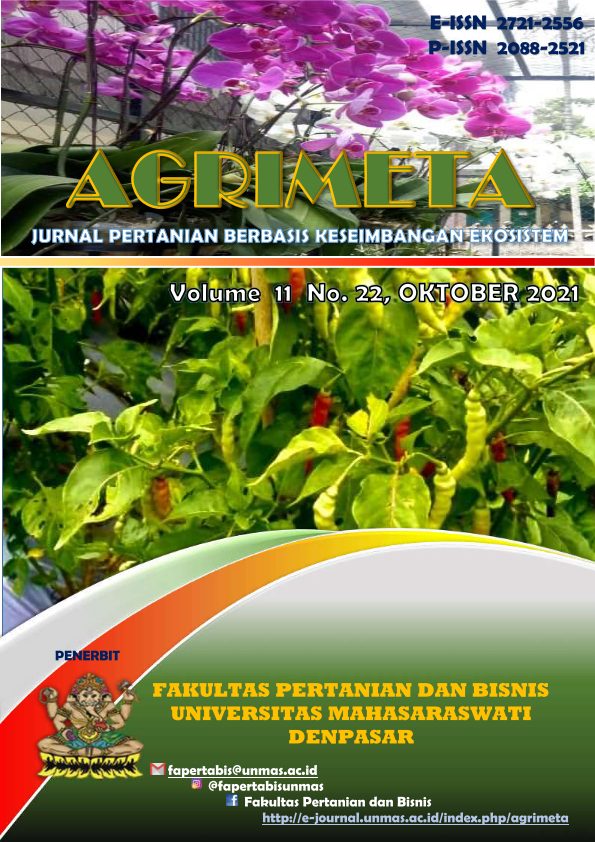Respon Pertumbuhan Dan Hasil Tanaman Sawi Pakcoy (Brassica chinensis L.) Akibat Pemberian Pupuk Kandang Sapi Dan Biourin Sapi
Keywords:
Pakcoy Mustard Plant, Dosage of Manure, Concentration of Cattle BiourineAbstract
Pokcoy mustard is one type of horticultural plant that is easy to cultivate, can grow optimally if they are planted on land that has high enough macro and micro nutrients. This study aims to determine the "Response of Growth and Yield of Pkacoy Mustard (Brassica chinensis L.) Due to Dosage of Manure and Concentration of Cattle Biourine. The method used is a Randomized Block Design (RAK) with factorial treatment with 2 treatment factors. Factor 1: Dosage of cow manure with 5 levels, namely K0 (without cow manure), K1 (30 gr/10 kg of soil), K2 (60 gr/10 kg of soil), K3 (90 g / 10 kg of soil), and K4 (120 g / 10 kg of soil). Factor 2: concentration of bovine biorin with 5 levels, namely B0 (without beef biorin), B1 (bovine biorin 80 ml/1 liter of water), B2 (160 ml/1 liter of water), B3 (240 ml/1 liter water), and B4 (320 ml/1 liter of water). The results showed that treatment (K4B4) with a dose of cow manure 120 g/10 kg of soil with a concentration of biourin 320 ml/1 liter of water gave the best growth compared to other treatments for all observation parameters such as plant height (cm), number of leaves (strands). , leaf area (cm²), total fresh weight (g), total oven dry weight (g), fresh weight without roots (g), and oven dry weight without roots (g). and the lowest was in the K0B0 treatment without a dose of manure and cow biourin concentration.
Downloads
References
Azisah, Muh. Izzdin Idrus, Arbiannah. 2017. Pengaruh Pemberian Pupuk Organik Cair Urine Sapi
Edi dan Bobiehoe. 2010. Budidaya Tanaman Sayur. Balai Pengkajian Teknologi Pertanian (BPTP). Jambi.
Hartatik, W., Widowati, L.R. 2006. Pupuk Kandang. Dalam: Simanungkalit, R.D.M., Suriadikarta, D.A., Saraswati, R., Setyorini, D., Hartatik, W,editor. Pupuk Organik dan Pupuk Hayati. Bogor: Balai Penelitian Sumberdaya Lahan Pertanian. Hal. 59-82.
Hesti. 2011. Dasar-Dasar Bercocok Tanam. Kanisius, Yogyakarta. Indriani. 2007.Membuat
Imelda Dada Gole, I Made Sukerta, Bagus Putu Udiyana. 2019. Pengaruh Dosis Pupuk Kandang Sapi Terhadap Pertumbuhan Tanaman Sawi (Brassica Juncea L.). Agrimeta. Vol. 9, No 18.
Kusuma, M. E. 2012. Pengaruh beberapa jenis pupuk kandang terhadap kualitas bokashi. J. Ilmu. Hewani. Tropika. 1 (2) : 41–46.
Rahmat. 2007. Pengaruh Perbedaan Jarak Tanam dan Pemberian Pupuk Hijau Terhadap Pertumbuhan dan Produksi Tanaman Sawi Pakchoy (Brassica Rapa L). Jurnal Penelitian Bidang Ilmu Pertanian, Kopertis Wilayah 1. Vol 2, No.1.
Wattimena, G. A. 1989. Zat pengatur tumbuh: peran fisiologis dan dasar-dasar pemakaian. Bul. Agron.(edisi khusus November)
Zulkarnain, M., B. Prasetya dan Soemarno.
Pengaruh Kompos, Pupuk Kandang dan Custom-Bio terhadap Sifat Tanah, Pertumubuhan dan Hasil Tebu (Saccharum officinarum L.) pada Entisol di Kebun Ngrangkah-Pawon, Kediri. Indonesian Green Technology Journal. 2(1): 45-5






